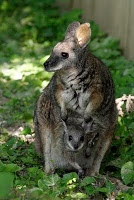
Tammar wallaby (photo by Mehgan Murphy, Smithsonian’s National Zoo)
Research published in the June 30 edition of Science Express features an analysis of the microbial content of the Tammar wallaby gut, which may inform strategies for diminishing greenhouse gas emissions from other ruminants.
Selected as a sequencing target by the DOE JGI’s Community Sequencing Program (CSP) in 2007, scientists had became interested in these mini kangaroos because of their similar digestive systems to cows, in addition to the fact that they release lower amounts of methane, and thus less of a carbon footprint. In 2009, the U.S. Environmental Protection Agency calculated that 20 percent of the nation’s human-related methane emissions were attributable to livestock digestive processes. In Australia, livestock emissions account for 12 percent of the country’s annual total greenhouse gas emissions.
To understand why these animals have much lower emissions levels, an international team of scientists including researchers at Australia’s Commonwealth Scientific and Industrial Research Organisation (CSIRO) and the DOE JGI collaborated to sequence and analyze the microbes found inside the Tammar wallaby’s gut that were believed to play a role in lower methane emissions. The Australian team then focused on one particular microbe identified in the metagenomic study. This information could then be applied toward decreasing global methane emissions produced by all livestock.
“Our multinational collaboration stems from support provided by the CSP. It has not only been a key for us to better understand the microbial aspects of plant digestion by the Tammar wallaby, but has also furthered our knowledge of the microbial world and its roles in energy production,” said study senior author Mark Morrison, a CSIRO Science Leader in Metagenomics who works in their Division of Livestock Industries.